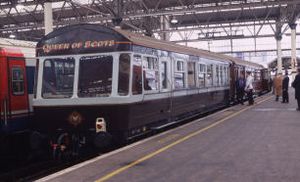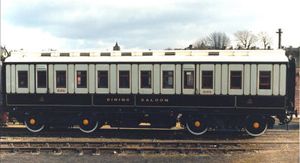The Queen of Scots
The Queen of Scots is a luxury touring train that ran exclusive tours around Scotland's scenic countryside. The train is mostly aimed at American tourists.
Contents
Fleet Details
| Car | Number | Built by | Place | Year Built |
|---|---|---|---|---|
| Observation Car | 41 | London and North Western Railway for West Coast Joint Stock | Wolverton | 1892 |
| Family Saloon | 807 | Great Northern Railway | Doncaster | 1912 |
| Dining Car | 5159 | London and North Western Railway | Wolverton | 1891 |
| Service Car No. 1 | Ex E35407 | British Railways | 1967 | |
| Service Car No. 2 | Ex E35322 | British Railways | 1967 |
WCJS Observation Car No. 41
Through-trains from London to Scotland on the West Coast route did not initially have dining cars although the morning and afternoon Scotch Expresses would stop en route at Preston for twenty minutes, in which time a full three-course meal would be served in the station dining room to all the passengers.
After many years of discussion about providing on-train dining facilities, in November 1891 the two West Coast companies agreed to add three pairs of purpose-built dining cars to the West Coast Joint Stock. Each pair consisted of a kitchen/third class diner coupled to a first class dining saloon, and entered service on 1 July 1892.
All of these dining cars were heated by a coal-fired stove and were lit by gas, but were converted to electric lighting in 1902. They remained as part of the West Coast Joint Stock until the summer of 1905 when they were allocated between the London and North Western Railway and the Caledonian Railway. The Caledonian took two of the diners, and renumbered one of them No. 41.
GNR Family Saloon No. 807
To allow wealthy families to travel in privacy between their London houses and their country estates, the old railway companies in Great Britain offered family saloons. These special carriages could be attached to the regular scheduled trains so that the whole family, the servants and all their luggage could travel together.
This car was built in 1912 as such a family saloon by the Great Northern Railway. The large centre room was the family room where the ladies and children travelled. To one side of this was the gentlemen's or smoking room, and the family toilet. At the other end of the coach there was originally a 3rd class compartment for the servants, a 3rd class toilet and a luggage area at the very end (hence the double doors). All this area has now been replaced by a library, although the servants' call indicator is still in place over the door leading through to the family room.
The Great Northern Railway was very strict about its design criteria, one being that 3rd class accommodation must always be narrower than lst class. Thus we have the unusual design detail that the family saloon was built narrower at one end (for the servants) than the other.
As the requirement for private carriages diminished, the family saloon was used less and less and eventually fell out of use. It was sold by British Railways in 1972, having latterly been used as a work-study office. The Family Saloon is finished in varnished teak - the Great Northern Railway had since the mid 19th century built all of their carriages out of solid teak.
LNWR Dining Car No. 5159
In response to a luxury carriage supplied by the American Pullman Company appearing on the Midland Railway, a competitor railway between London and Manchester, the London and North Western Railway built this Dining Car especially for its Manchester expresses. It was built as one of a pair of coaches which ran permanently coupled together and entered service in July 1890. No 5159 had a kitchen and seating for 10 passengers, while its partner had seating for 20 and no kitchen. Although there was access from one coach to the other (and two toilets) it was not possible to walk into the other coaches in the train - this was not yet a common facility. Consequently passengers booked to spend their entire journey in the dining car. Two years later, when provision was made for passengers to walk through, doorways were simply cut into the ends of the carriage. Thus at the kitchen end of the coach passengers would pass through the kitchen.
Because of its small size, it was soon replaced by a much larger carriage and so found itself relegated to secondary services. During the Great War it was requisitioned by the Army and taken to France as part of a mobile HQ for Field Marshal Earl Haig.
After the War the LNWR declined to have it back, so in 1921 it was used to make a house at Middleton on Sea on the south coast of England near Southampton. In 1978 it was "rescued" and has now been restored as closely as possible to original, while taking into account modern standards of cooking, safety and comfort.
The Dining Car is painted in the livery of the London and North Western Railway, the splendidly named Plum and Spilt Milk.
It is the oldest Dining Car in the world.



